
Topics
Downtown Community Television is launching an anti-gun violence tour in New York City and elsewhere featuring the award-winning film “Bullets in the Hood: A Bed-Stuy Story.” The film was made by two 19 year-olds, raised in Brooklyn’s public housing projects, who had lost 11 friends to gun-violence in the streets of New York. [includes rush transcript]
We end today’s program looking at the issue of gun violence. Downtown Community Television–located in the same firehouse studios we are broadcasting out of–is launching an anti-gun violence tour in New York City and the Tri-State area.
The tour features the film “Bullets in the Hood: A Bed-Stuy Story” produced at DCTV. The film was made by two 19 year-olds, raised in Brooklyn’s public housing projects, who had lost 11 friends to gun-violence in the streets of New York City. Instead of picking up a gun, they picked up cameras, and made a movie to try and put an end to the violence.
The film focuses on the fatal shooting of Timothy Stansbury by a police officer on the roof of a Bedford-Stuyvesant housing project on January 24th, 2004. He was 19 years old. His friend Terrence Fisher was standing behind him when he was shot.
Terrence documented the tense hours and days after the shooting with a fellow filmmaker. The result was the film Bullets in the Hood: A Bed-Stuy Story. It was been screened at national and international film festivals including Sundance, where it won the 2005 Special Jury Prize in Short Filmmaking.
- “Bullets in the Hood: A Bed-Stuy Story”, excerpt of documentary.
- Jon Alpert, award-winning filmmaker and founder of Downtown Community Television.
- Terrence Fisher, director of Bullets in the Hood: A Bed-Stuy Story.
- Phyllis Clayburne, her son, Timothy Stansbury, was shot dead by a police officer on the roof of a Bedford-Stuyvesant housing project on January 24th, 2004. He was 19 years old.
Transcript
AMY GOODMAN: We’re joined right now by one of the people who made that film, Terrence Fisher. We’re also joined by Jon Alpert, who heads up Downtown Community Television. We’re going to show the clip in a minute and talk about — though I wanted to ask Jon if you could talk about this tour. The film was made a little while ago, but now you’re taking it on tour. As mayors around the country deal with gun violence in a summit, you’re doing it in a different way.
JON ALPERT: Yeah, we thought that really one of the things that might help this, because so far the problem seems to be proving insoluble, is basically a grassroots effort and if the people in their own communities can basically begin to fix something that’s incredibly broken. We were at a school yesterday. There were 125 kids there. And the principal, a guy that comes from the neighborhood, said, “Anybody who has lost someone to gun violence, a relative or a close friend, raise their hand.” And every single hand went up. And when he said, “Anybody know a kid that has a gun?” and every single hand went up. I mean, it’s insane.
I spent last summer in Baghdad, and young Americans — two young Americans every day are dying in Baghdad. Every three hours, a young person like Terrence is being shot and killed in the streets. It’s an astonishing epidemic. And we thought that this powerful film, made by a young person who could be running around on the streets with a gun but instead is running around with a camera, can serve as an inspiration. And, basically, young people have to fix this themselves. They have to make that decision. Otherwise, the only thing that’s really being talked about is more cops and more guns.
JUAN GONZALEZ: Jon, interestingly, the national media coverage in recent years says the crime rate has continued to drop. You see almost no attention now to the issue of gun violence and crime in a lot of neighborhoods around the country. It’s almost as if the problem has disappeared.
JON ALPERT: Well, we can toss statistics, or we can ask Terrence. I mean, is your neighborhood safer now than it was or do more kids have guns?
TERRENCE FISHER: I mean, it’s safe now. I mean, like a lot of people are realizing what’s going on, and we’re trying our best to, like, you know, put an end to whatever’s going on right now.
JON ALPERT: But are kids still getting killed?
TERRENCE FISHER: I mean, no. I mean, people in my community don’t die every day. I mean, things just happen often, you know?
AMY GOODMAN: Well, we want to go to a clip of your film, but before we do, since Jon, you’re going to have to leave us before — as the film, we play a clip of it, your film, Baghdad E.R., is going to air on May 21 on HBO, just got a big write-up by Bob Herbert in the New York Times op-ed page. How do you contrast working on these two different films? I mean, Terrence was the filmmaker here; you were quite involved.
JON ALPERT: Right. Terrence made a great film, and he made a film that maybe I couldn’t make, because he was able to talk to the kids in the neighbor, to the people who have really been suffering, in a very intimate way. But it’s sort of the same thing. It’s war in Baghdad, and it’s war in Brooklyn. And maybe Terrence’s neighborhood is safer this month, but the principal didn’t think that, and he says, “I’m putting a lot of effort into these kids, and they’re all going to die.”
AMY GOODMAN: We’re going to go now to a clip of Bullets in the Hood.
TERRENCE FISHER: It has been eight months since the shooting of Timothy Stansbury occurred. I just want to know when we’re going to get some justice. I know eight people that has been shot and killed by guns. I just want to introduce you to a few of them right now.
This is Kevin West a.k.a. Cash Dro. He was a friend of the block. He was like a brother to me, big brother. He was shot and killed by a gun. His name Jamel a.k.a. Jal. He has been shot and killed by a gun, and he was close to everybody that was on the block. We have Stapo right here, a.k.a. Aid Pop. He had been shot and killed by a gun, and he was well known to the block. This is the last mural right here: Timothy Stansbury a.k.a. Drag. We called him Drag, because his favorite rapper was Drag On. Drag, I love you, dog. You’re my heart, man. Word up, man.
And that’s the last part. Timothy had got shot. I’m 19 years old right now. It could be me next. It could be you. You never know. It’s just a lot of gun violence going on in my community right now. I just want to know when it’s going to stop.
AMY GOODMAN: An excerpt of the documentary, Bullets in the Hood: A Bed-Stuy Story. Filmmaker Terrence Fisher joins us in the studio today. We’re also joined by Phyllis Clayburne, the mother of Timothy Stansbury, who was shot dead by a police officer January 2004 and is the focus of the film. I wanted to ask you about your son and what happened.
PHYLLIS CLAYBURNE: From what I’m to understand, on the night of the 24th of January he was coming from a party on his way to pick up some CDs to go back to the party, when he was approached by an officer, and he was shot and killed on his way up the stairs. He hadn’t even reached through the doorstep yet, and this is when he was fatally shot by the officer, Richard Neri.
JUAN GONZALEZ: He was actually coming over the roof from one building to another in the neighborhood. I remember writing about the incident, and the officers had their guns drawn right on the roof.
PHYLLIS CLAYBURNE: Yes, yes. Doing a vertical — what they call, in a vertical patrol. From what I’m to understand, again, is that they were coming from the party, because they wanted to take a short cut. Instead of going down five flights of steps, they took the short cut over the roof to go down one flight to come back over to one flight, because if they had to taken the steps, they had to take five steps down, five steps up. So they just took a short cut to go over. And that’s what happened.
JUAN GONZALEZ: And what has happened since that shooting? Did anything happen to the officer?
PHYLLIS CLAYBURNE: I call it a promotion, because he’s in a safe hold right now. He’s now a delegate for P.B.A. I don’t think he’ll ever be faced with charges. And that’s like a slap in my face, because of the fact that I work for NYPD, as well. I figure that they would have given him some disciplinary acts, but they haven’t. Why, I don’t know. I would like to know why. And I have a lot of questions, because the commissioner himself said it was unjustifiable. I have not seen any justification on this situation yet. So, to me, again, it’s a slap in my face, and it’s saying to me that it’s okay when police officers do these types of things and they can get away with it. And this makes the people think that the city is corrupt with cops, if they continue to allow them to do this and not be reprimanded for the things that they do.
AMY GOODMAN: Terrence, you knew Timothy?
TERRENCE FISHER: Yes, he was like a brother to me.
AMY GOODMAN: So how did you go from being his close friend to making this movie.
TERRENCE FISHER: I mean, I was already shooting the movie before it already happened. My brother had got shot. And so, I just wanted to talk about my brother and my friends that had been shot by a gun. So, Timothy — the whole situation with Timothy had occurred, and so I felt like I wanted to talk about what happened to Timothy.
AMY GOODMAN: And what happened as you made this film? Did it change your view of your neighborhood? Of your own life?
TERRENCE FISHER: Yeah, I mean, I just showed like the actual, like, the view, like how you can be gone within a couple of seconds from a gun, you know. And I’m just trying to take it around and just show everybody, like, guns is a bad thing.
AMY GOODMAN: So, yesterday you were in Brooklyn.
TERRENCE FISHER: Yes.
AMY GOODMAN: On Ralph Avenue.
TERRENCE FISHER: Yes.
AMY GOODMAN: All of these kids say they know people killed by guns, they know people who have guns. And you’re taking it all over.
TERRENCE FISHER: Yes.
JUAN GONZALEZ: And you were there when he was shot, right? In terms of your recollection of those moments and what you heard in the police reports afterwards, what were some of the main differences?
TERRENCE FISHER: I mean, I just know — now I know how, you know, how they try to cover up stories and try to switch up stories and try to say — I mean, I was there, I know what happened from detail to detail. So, I mean, like just by reading what happened and — I mean, the majority of that stuff really didn’t happen.
JUAN GONZALEZ: Did the police ever identify themselves when they came?
TERRENCE FISHER: No.
JUAN GONZALEZ: Never. They just fired?
TERRENCE FISHER: Never. I didn’t even know it was police that did it until I heard their walky-talkies when I got into my apartment and I seen them.
AMY GOODMAN: What do you hope will come out of this film? I mean, you showed it at Sundance. It’s gotten international acclaim. Now, you’re taking it to poor neighborhoods. You’re showing it on the side of the DCTV cyber-car. You’re showing the film on the streets.
TERRENCE FISHER: Yeah, I mean, I just hope that this just be the last tragic thing that ever happened to a young teen in our community. I mean, if we don’t try to do something to stop this, they’re going to keep continue killing us. So that’s why I’m just trying to take this around and show everybody what they’re doing to us and how can we make things better.
JUAN GONZALEZ: And do you get a sense from the teenagers that you speak to how the guns are getting into the neighborhoods?
TERRENCE FISHER: I mean, there’s a lot of feedback when I ask that question. They really don’t know how it was getting into our communities. But, I mean, it’s here.
AMY GOODMAN: Phyllis Clayburne, what do you hope is going to come out of the film and of any kind of investigation, if it ever happens?
PHYLLIS CLAYBURNE: Well, I’m hoping that we can teach our kids that there are so many more things in life that we can do besides pull out a gun and shoot someone. Whether it be a police officer killing a child, whether your child is killing another child with guns, guns are dangerous. We have to get them off the streets, because we are at war. We are at war more so than over there in the other countries. We are at war here. And we have to kind of like put ourselves together and say, well, enough is enough. We have to put it to the people who really can do something about it and say enough is enough. The guns are killing our children. It just has to be put to a stop. Guns are very dangerous, and we just have to, like I said, focus on the children, from them to the next generation to the next generation, that guns aren’t the answer. There are much more things that you can do, positive things.
AMY GOODMAN: Well, I want to thank you both very much for being with us. Terrence Fisher, director of Bullets in the Hood: A Bed-Stuy Story. We’ll link at our website, democracynow.org, to your tour and to information about the film. Phyllis Clayburne, her son Timothy Stansbury was shot dead by a police officer on their roof of a Bedford-Stuyvesant housing project, January 2004. He was 19. Thanks both for being with us.

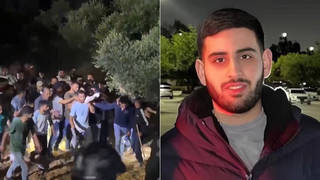
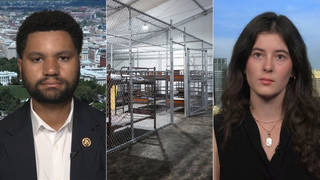
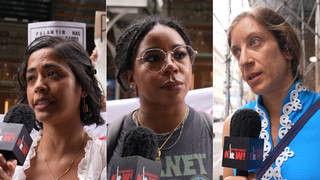
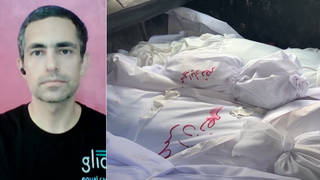
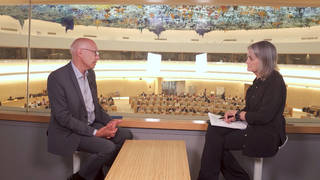


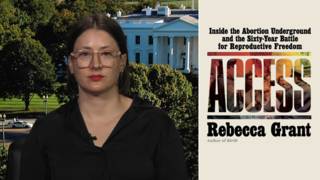

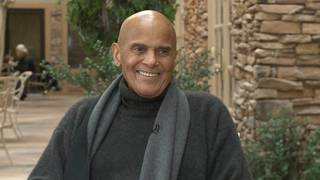


Media Options